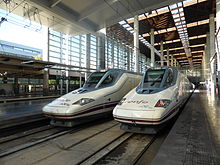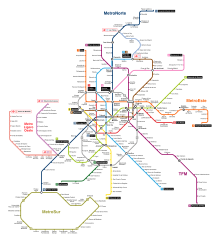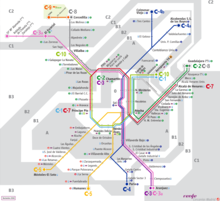Most of the transport system in Ireland is in public hands, either side of the Irish border. The Irish road network has evolved separately in the two jurisdictions into which Ireland is divided, while the Irish rail network was mostly created prior to the partition of Ireland.

Transport in Spain is characterised by an extensive network of roads, railways, rapid transit, air routes, and ports. Its geographic location makes it an important link between Europe, Africa, and the Americas. Major forms of transit generally radiate from the capital, Madrid, located in the centre of the country, to link with the capitals of the autonomous communities.

Adolfo Suárez Madrid–Barajas Airport, commonly known as Madrid–Barajas Airport, is the main international airport serving Madrid in Spain. At 3,050 ha in area, it is the second-largest airport in Europe by physical size behind Paris–Charles de Gaulle Airport. In 2019, 61.8 million passengers travelled through Madrid–Barajas, making it the country's busiest airport as well as Europe's fifth-busiest.

The Madrid Metro is a rapid transit system serving the city of Madrid, capital of Spain. The system is the 14th longest rapid transit system in the world, with a total length of 293 km (182 mi). Its growth between 1995 and 2007 put it among the fastest-growing networks in the world at the time, rivaling many Asian metros such as the Mass Transit Railway, Shanghai Metro, Guangzhou Metro, Beijing Subway, and Delhi Metro. However, the European debt crisis greatly slowed expansion plans, with many projects being postponed and canceled. Unlike normal Spanish road and rail traffic, which drive on the right, Madrid Metro trains use left-hand running on all lines because traffic in Madrid drove on the left until 1924, five years after the system started operating.

Renfe, officially Renfe-Operadora, is the national passenger railway company of Spain.

Rail transport in Spain operates on four rail gauges and services are operated by a variety of private and public operators. The total route length in 2012 was 16,026 km.

Alcobendas is a municipality of Spain located in the Community of Madrid.

Cercanías Madrid is the commuter rail service that serves Madrid, the capital of Spain, and its metropolitan area. It is operated by Cercanías Renfe, the commuter rail division of Renfe, the former monopoly of rail services in Spain. Its total length is 370 km.
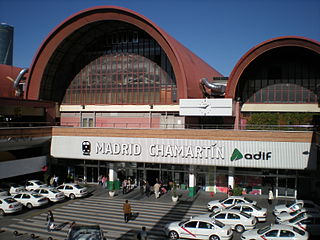
The Estación de Madrid-Chamartín Clara Campoamor or Madrid Chamartín is the second major railway station in Madrid, Spain. Located on the northern side of the city, it was built between 1970 and 1975, but more work was carried on into the early 1980s. It then superseded Atocha station, which is located just south of the city centre. However, as the AVE network expanded with a hub at Atocha, Chamartin again became Madrid's second station by passenger volume.

Barcelona Sants is the main railway station in Barcelona, owned by Adif, the railway infrastructure agency of Spain. It has become the most important transport hub of the city - being the centre of Rodalies de Catalunya including Barcelona suburban railway services and regional services, as well as the main inter-city station for national and international destinations. The station is named after Sants, the neighbourhood of Barcelona in which it is located. New parts of the station have recently been remodeled to accommodate the Spanish high-speed train AVE in the city, which started serving the city on 20 February 2008. There is also an adjacent international bus station bearing the same name, and a link to the Sants Estació metro station that serves the railway station.

Cercanías Murcia/Alicante is a commuter rail service (cercanías) in the provinces of Alicante and Murcia. The line connects Alicante and Murcia with San Vicente del Raspeig, Elche, Orihuela, Totana, Lorca, and Águilas. It runs through 200 km of railways with a total of 26 stations.

Nuevos Ministerios is a major multimodal rail station on the Madrid Metro and the Cercanías Madrid commuter rail network. It is located beneath the Nuevos Ministerios government complex and the AZCA financial centre at the junction of the Paseo de la Castellana and Joaquín Costa and Raimundo Fernández Villaverde streets in Madrid, Spain. It services the districts of Tetuán, Chamberí, and Chamartín. The station serves Metro Line 6, Line 8, and Line 10, as well as Cercanías Lines C-1, C-2, C-3, C-4, C-7, C-8, and C-10. It is located in Metro fare zone A and Cercanías fare zone 0.
Public transport in Barcelona is operated by several companies, most of which are part of the Autoritat del Transport Metropolità, a transport authority managing services in the Barcelonès and the rest of the metropolitan area of Barcelona. This article is a summary with transport facilities and services strictly within the municipality of Barcelona, and contains links to more specific articles.

After it became the capital of Spain in the 16th century, Madrid was more a centre of consumption than of production or trade. Economic activity was largely devoted to supplying the city's own rapidly growing population, including the royal household and national government, such trades as banking and publishing.
Valdebebas is an urban development under construction in the city of Madrid, Spain near Barajas Airport. It will host around 12,500 apartments and houses for a population of 40,000 inhabitants. The Valdebebas Woodland Park is being constructed with an area of 500 hectares. The neighbourhood will also have retail spaces, offices, hotels, and public facilities.
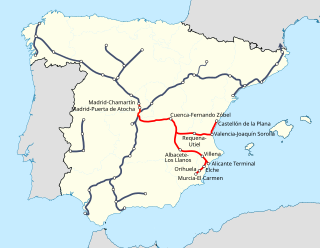
The Madrid–Levante high-speed network is a network of high-speed rail lines that connects Madrid with the Mediterranean coast of the Levante Region, specifically with Castilla-La Mancha, the Valencian Community and the Murcia Region autonomous communities.

The C-1 is a rail service of Cercanías Madrid commuter rail network, operated by Renfe Operadora. It runs from Príncipe Pío station in western Madrid to Madrid Barajas Airport Terminal 4, through the city center of Madrid. The C-1 shares tracks for the majority of its length with services C-7 and C-10 while it also shares large parts with C-2, and C-8. The service has existed in its current form since 2011, when it opened.

The C-10 is a line and rail service of Cercanías Madrid commuter rail network, operated by Renfe Operadora. It runs from Villalba northwest Madrid to Fuente de la Mora, through the city center of Madrid, while trains can continue onwards to Madrid Barajas Airport. The C-10 shares tracks for the majority of its length with Madrid commuter rail service lines C-3, C-7 and C-8 while it also shares parts with C-1, and C-2. The line has been in operation since 2001.
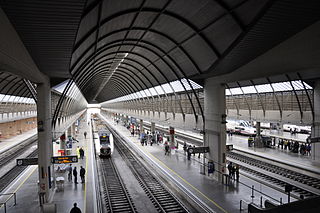
Seville-Santa Justa railway station is the major railway station of the Spanish city of Seville, Andalusia. It was opened in 1991 with the inauguration of the Madrid–Seville high-speed rail line, and serves around 9.25 million passengers a year.
The Alcázar de San Juan–Cádiz railway is an important Iberian-gauge railway line in Spain. It branches from the Madrid–Valencia railway at Alcázar de San Juan and terminates in Cádiz. It was once the only line linking Madrid to Seville, but now primarily serves local commuter rail services and regional traffic since the opening of the Madrid–Seville high-speed rail line in 1992.
